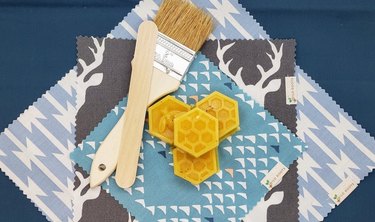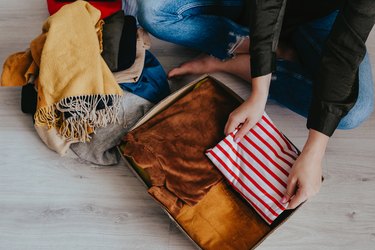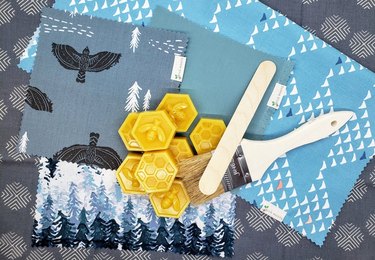No matter what our chosen craft and unique set of skills, there are a few things we DIYers all have in common – we've got projects to complete and we need materials and tools to get them done. Some of us get so hyper-focused on the objective that we don't spend much time thinking about how or where we get our tools and materials. And then there are those who may love the materials more than what they make out of them (looking at you, yarn stashers!). Either way, we tend to accumulate a lot of stuff, and that adds up to huge costs, lots of trips to Home Depot or Joann and countless online orders. Not only does this mean dwindling storage space for us, but our habits can be very unkind to the planet. But here's the thing – with just a a little bit of extra thought and pre-planning, you can be a much more eco-friendly DIYer.

1. Use What You Already Have
Before heading off to JOANN because you came across a tutorial for a no-sew handbag, take stock of the materials you already have on hand and get ideas from them. Have a bunch of leftover PCV pipe from a plumbing repair? Simply Google "PVC DIY Projects" and see if the search results provide any inspo. You can also scavenge your closet, garage, and/or basement for old items that you can either upcycle or cannibalize for their parts. I assure you that you'll find a wealth of crafting materials in your own home and no end of ideas online for what to make with them.

2. Make What You Actually Need
So you saw an ingenious IKEA furniture hack on Pinterest and decided you must make it? Great – but first ask yourself, "Do I need another side table?" If the answer is no, then ask yourself, "Does anyone I know need one and do I owe them a gift?" Still no? Well. Maybe rethink this project before going out and buying that LACK to hack. Instead, ask yourself what you were planning on buying anyway, and look into what it would take to make it yourself. Let's say you need some furniture for the playroom and realize that you can paint a checkerboard surface on a LACK table you already own using chalk paint? Well then, go to town!
 Have an extra side table and your checkers loving kids need furniture for their playroom? Here’s the DIY for you! Image Credit: Carrie Waller
Have an extra side table and your checkers loving kids need furniture for their playroom? Here’s the DIY for you! Image Credit: Carrie Waller
3. Borrow Tools From Friends
You want to take your jewelry-making skills to the next level by learning how to solder, but don't have a soldering torch? Before you run out and buy one, ask your social network if anyone owns one that they can lend you while you learn. You might discover that soldering isn't your thing, so you can simply return it and move on. And if your crafter network is large, chances are high that may have one they no longer use and is willing to sell you theirs at a discounted price. A win-win-win situation between you, your buddy, and the planet. And if you discover that soldering is the hobby you've been waiting for all your life, well then, you've earned the right to purchase a brand new jewelry soldering kit. Plus, having some experience, you'll have a better idea about which one would best suit your needs.
 No jewelry soldering tools? Before buying, ask around to see if a friend can lend you theirs. Image Credit: Etsy
No jewelry soldering tools? Before buying, ask around to see if a friend can lend you theirs. Image Credit: Etsy
4. Make Less Trips & Combine Online Deliveries
So you almost have enough jumper rings for the earrings you're making for an entire bridal party, but find that you'll still need to get more. Before you rush out the door or click that "Place Order" button, stop and think about whether or not you've taken stock of everything you'll be needing for this project and, perhaps, another one you've got planned a couple weeks down the line. Planning ahead means less trips to the store (i.e. less fuel consumption) and making multiple purchases in one online order from the same seller on Etsy means less shipping materials used. If you're buying from Amazon, choose the option to combine multiple orders in one shipment. A little pre-planning for less natural resource consumption will go a long way for Mother Earth! Another easy way to make less trips is to buy an all-in-one craft kit, like this Eco-Friendly Earring Making Kit from Sumsaara on Etsy.

5. Choose Waste-Reducing Projects
When selecting your next project, choose something that'll actually help you live a greener lifestyle. Take a look around the house and see if there are any one-use items that you can replace with a reusable alternative – like ditching plastic wrap for eco-friendly beeswax food wraps. In this case, you can totally DIY your own using a kit like this one from Wild Roots Living on Etsy. Other waste-reducing DIY projects include no-sew produce bags, fabric bowl covers and Bernie Sanders-esque mittens made from old sweaters.

Make Green and Buy Green
Finally, when you purchase materials and tools, it's important to make eco-friendly choices regarding what you buy and where you buy them. Support businesses that have made commitments to be more environmentally friendly like Blick, Wool And The Gang, and the many eco-conscious shops on Etsy.
To find more, check out our list of 10 Best Places to Find Eco-Friendly Craft & Art Supplies.


